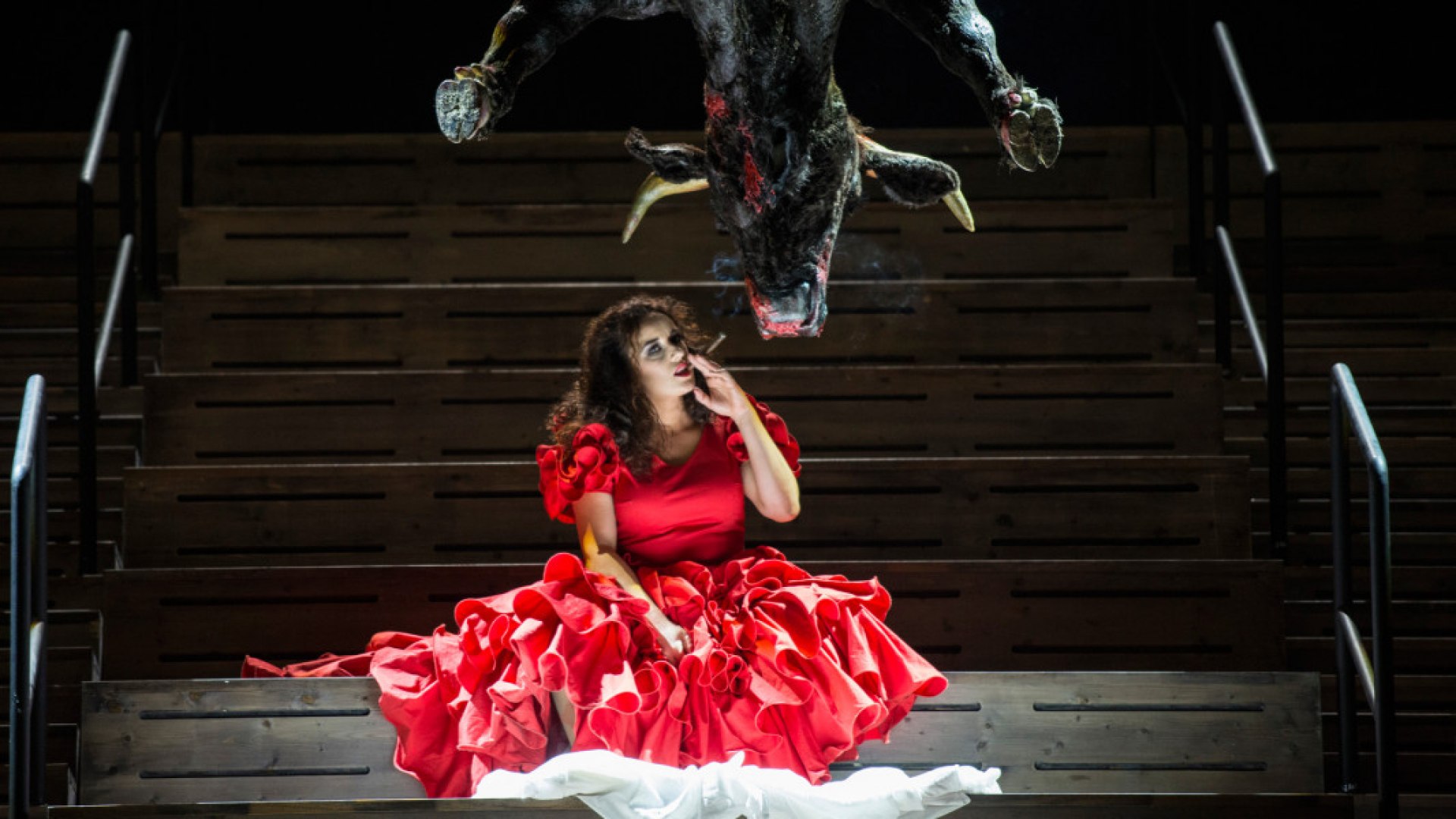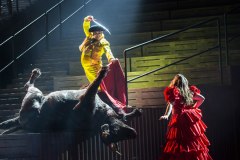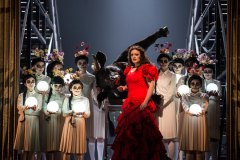Carmen
Mo | Tu | We | Th | Fr | Sa | Su |
Carmen - Georges Bizet (1838 – 1875)
Opéra Comique in Four Acts by Georges Bizet
Libretto by Meilhac and Ludovic Halévy
Based on a Novella by Prosper Mérimée
Recommended for Ages 14 and Up
Synopsis
Place: Seville, Spain, and surrounding hills
Time: Around 1820
Act 1
A square, in Seville. On the right, a door to the tobacco factory. At the back, a bridge. On the left, a guardhouse.
A group of soldiers relaxes in the square, waiting for the changing of the guard and commenting on the passers-by ("Sur la place, chacun passe"). Micaëla appears, seeking José. Moralès tells her that "José is not yet on duty" and invites her to wait with them. She declines, saying she will return later. José arrives with the new guard, which is greeted and imitated by a crowd of urchins ("Avec la garde montante").
As the factory bell rings, the cigarette girls emerge and exchange banter with young men in the crowd ("La cloche a sonné"). Carmen enters and sings her provocative habanera on the untameable nature of love ("L'amour est un oiseau rebelle"). The men plead with her to choose a lover, and after some teasing she throws a flower to Don José, who thus far has been ignoring her but is now annoyed by her insolence.
As the women go back to the factory, Micaëla returns and gives José a letter and a kiss from his mother ("Parle-moi de ma mère!"). He reads that his mother wants him to return home and marry Micaëla, who retreats in shy embarrassment on learning this. Just as José declares that he is ready to heed his mother's wishes, the women stream from the factory in great agitation. Zuniga, the officer of the guard, learns that Carmen has attacked a woman with a knife. When challenged, Carmen answers with mocking defiance ("Tra la la... Coupe-moi, brûle-moi"); Zuniga orders José to tie her hands while he prepares the prison warrant. Left alone with José, Carmen beguiles him with a seguidilla, in which she sings of a night of dancing and passion with her lover—whoever that may be—in Lillas Pastia's tavern. Confused yet mesmerised, José agrees to free her hands; as she is led away she pushes her escort to the ground and runs off laughing. José is arrested for dereliction of duty.
Act 2
Lillas Pastia's Inn
A month has passed. Carmen and her friends Frasquita and Mercédès are entertaining Zuniga and other officers ("Les tringles des sistres tintaient") in Pastia's inn. Carmen is delighted to learn of José's release from a month's detention. Outside, a chorus and procession announces the arrival of the toreador Escamillo ("Vivat, vivat le Toréro"). Invited inside, he introduces himself with the "Toreador Song" ("Votre toast, je peux vous le rendre") and sets his sights on Carmen, who brushes him aside. Lillas Pastia hustles the crowds and the soldiers away.
When only Carmen, Frasquita and Mercédès remain, the smugglers Dancaïre and Remendado arrive and reveal their plans to dispose of some recently acquired contraband ("Nous avons en tête une affaire"). Frasquita and Mercédès are keen to help them, but Carmen refuses, since she wishes to wait for José. After the smugglers leave, José arrives. Carmen treats him to a private exotic dance ("Je vais danser en votre honneur ... La la la"), but her song is joined by a distant bugle call from the barracks. When José says he must return to duty, she mocks him, and he answers by showing her the flower that she threw to him in the square ("La fleur que tu m'avais jetée"). Unconvinced, Carmen demands he shows his love by leaving with her. José refuses to desert, but as he prepares to depart, Zuniga enters looking for Carmen. He and José fight, and are separated by the returning smugglers, who restrain Zuniga. Having attacked a superior officer, José now has no choice but to join Carmen and the smugglers ("Suis-nous à travers la campagne").
Act 3
A wild spot in the mountains
Carmen and José enter with the smugglers and their booty ("Écoute, écoute, compagnons"); Carmen has now become bored with José and tells him scornfully that he should go back to his mother. Frasquita and Mercédès amuse themselves by reading their fortunes from the cards; Carmen joins them and finds that the cards are foretelling her death, and José's. The women depart to suborn the customs officers who are watching the locality. José is placed on guard duty.
Micaëla enters with a guide, seeking José and determined to rescue him from Carmen ("Je dis que rien ne m'épouvante"). On hearing a gunshot she hides in fear; it is José, who has fired at an intruder who proves to be Escamillo. José's pleasure at meeting the bullfighter turns to anger when Escamillo declares his infatuation with Carmen. The pair fight ("Je suis Escamillo, toréro de Grenade"), but are interrupted by the returning smugglers and girls ("Holà, holà José"). As Escamillo leaves he invites everyone to his next bullfight in Seville. Micaëla is discovered; at first, José will not leave with her despite Carmen's mockery, but he agrees to go when told that his mother is dying. As he departs, vowing he will return, Escamillo is heard in the distance, singing the toreador's song.
Act 4
A square in Seville. At the back, the walls of an ancient amphitheatre
Zuniga, Frasquita and Mercédès are among the crowd awaiting the arrival of the bullfighters ("Les voici ! Voici la quadrille!"). Escamillo enters with Carmen, and they express their mutual love ("Si tu m'aimes, Carmen"). As Escamillo goes into the arena, Frasquita warns Carmen that José is nearby, but Carmen is unafraid and willing to speak to him. Alone, she is confronted by the desperate José ("C'est toi ! C'est moi !"). While he pleads vainly for her to return to him, cheers are heard from the arena. As José makes his last entreaty, Carmen contemptuously throws down the ring he gave her and attempts to enter the arena. He then stabs her, and as Escamillo is acclaimed by the crowds, Carmen dies. José kneels and sings "Ah! Carmen! ma Carmen adorée!"; as the crowd exits the arena, José confesses to killing the woman he loved.
About the performance
About the work
Georges Bizet’s titular heroine is as captivating a character as any in the history of opera. The different interpretations of Carmen are legion: we have the seductress, the personification of forbidden yearning, the standard bearer for the “eternally female” in the brutal battle of the sexes, the anarchist unfettered by bourgeois angst and compulsions, the archaic clairvoyante seeing her own death in the cards - yet free, as she does not dread her destiny. Few opera heroines are so open to interpretation and hence so able to serve as a mirror held up to society.
With CARMEN Bizet was throwing down the gauntlet to Romantic opera. His naturalistic presentation of a proletarian milieu with its poverty and crime was a direct challenge to the conventions of opera. It is a setting in which Don José’s dreams are doomed to be dashed. His fixation on Carmen sucks him into a pit of wretchedness and felony and he persistently rejects his chance to lead a steady, secure life with Micaëla the peasant girl.
This clash of principles – feminine versus masculine; bourgeoisie versus anarchy – is illustrated by the bullfighting scene, which is much more than a colourful bit of folklore used as a backdrop to the storyline; it is a gory ritual involving the survival of the fittest, where no quarter is given.
About the production
In his version Norwegian director Ole Anders Tandberg has embraced the unique blend of great opera, working-class tragedy and overstoked operetta. He packs his triumphant ramped-up production with emotional realism, bloody corrida symbolism and grotesque, Tarantino-esque scenes of absurd cruelty. And the iconic character of the work is playfully reflected in the opulent Andalusian garb of Carmen and Escamillo.
Tandberg is interested in the eponymous heroine’s openness and the mystery surrounding her. He sees in her not just the seer, the anarchist or the focus of male gaze but also a person playing these different roles for fear of emotional injury, a woman who is led by Don José’s true love to glimpse, at least for isolated moments, behind the façade of her own Carmen poses.
Program and cast
Duration: 3 hrs / 1 interval
In French with German and English surtitles
Pre-performance lecture (in German): 45 minutes prior to each performance
First performed on 3rd March 1875, in Paris
Premiered at the Deutsche Oper Berlin on 20th January 2018
Cast
Conductor: Ariane Matiakh, Giulio Cilona (09.06.2025 | 14.06.2025 | 22.06.2025)
Stage direction: Ole Anders Tandberg
Set design: Erlend Birkeland
Costume design: Maria Geber
Light design: Ellen Ruge
Chorus Master: Jeremy Bines
Children’s chorus: Christian Lindhorst
Choreography: Silke Sense
Carmen: Maria Kataeva, Annika Schlicht (09.06.2025 | 14.06.2025 | 22.06.2025)
Frasquita: Alexandra Oomens, Meechot Marrero (09.06.2025 | 14.06.2025 | 22.06.2025)
Mercédès: Arianna Manganello, Martina Baroni (12.09.2024 | 21.09.2024 | 09.06.2025 | 14.06.2025 | 22.06.2025)
Micaëla: Sua Jo, Nina Solodovnikova (12.09.2024 | 21.09.2024), Maria Motolygina (09.06.2025 | 14.06.2025 | 22.06.2025)
Don José: Matthew Newlin, N. N. (09.06.2025 | 14.06.2025 | 22.06.2025)
Moralès: Dean Murphy, Thomas Lehman (21.09.2024), Geon Kim (09.06.2025 | 14.06.2025 | 22.06.2025)
Zuniga: Padraic Rowan, Jared Werlein (09.06.2025 | 14.06.2025 | 22.06.2025)
Escamillo: Byung Gil Kim
Remendado: Thomas Cilluffo, Kieran Carrel (09.06.2025 | 14.06.2025 | 22.06.2025)
Dancairo: Philipp Jekal, Artur Garbas (21.09.2024 | 09.06.2025 | 14.06.2025 | 22.06.2025)
Chorus: Kinderchor der Deutschen Oper Berlin
Chorus: Chor der Deutschen Oper Berlin
Orchestra: Orchester der Deutschen Oper Berlin
Deutsche Oper Berlin
The Deutsche Oper Berlin is an opera company located in the Charlottenburg district of Berlin, Germany. The resident building is the country's second largest opera house and also home to the Berlin State Ballet.
The company's history goes back to the Deutsches Opernhaus built by the then independent city of Charlottenburg—the "richest town of Prussia"—according to plans designed by Heinrich Seeling from 1911. It opened on November 7, 1912 with a performance of Beethoven's Fidelio, conducted by Ignatz Waghalter. After the incorporation of Charlottenburg by the 1920 Greater Berlin Act, the name of the resident building was changed to Städtische Oper (Municipal Opera) in 1925.
Deutsches Opernhaus, 1912
With the Nazi Machtergreifung in 1933, the opera was under control of the Reich Ministry of Public Enlightenment and Propaganda. Minister Joseph Goebbels had the name changed back to Deutsches Opernhaus, competing with the Berlin State Opera in Mitte controlled by his rival, the Prussian minister-president Hermann Göring. In 1935, the building was remodeled by Paul Baumgarten and the seating reduced from 2300 to 2098. Carl Ebert, the pre-World War II general manager, chose to emigrate from Germany rather than endorse the Nazi view of music, and went on to co-found the Glyndebourne opera festival in England. He was replaced by Max von Schillings, who acceded to enact works of "unalloyed German character". Several artists, like the conductor Fritz Stiedry or the singer Alexander Kipnis followed Ebert into emigration. The opera house was destroyed by a RAF air raid on 23 November 1943. Performances continued at the Admiralspalast in Mitte until 1945. Ebert returned as general manager after the war.
After the war, the company in what was now West Berlin used the nearby building of the Theater des Westens until the opera house was rebuilt. The sober design by Fritz Bornemann was completed on 24 September 1961. The opening production was Mozart's Don Giovanni. The new building opened with the current name.

 EN
EN DE
DE IT
IT FR
FR ES
ES RU
RU JP
JP RO
RO
 Seating plan
Seating plan 





